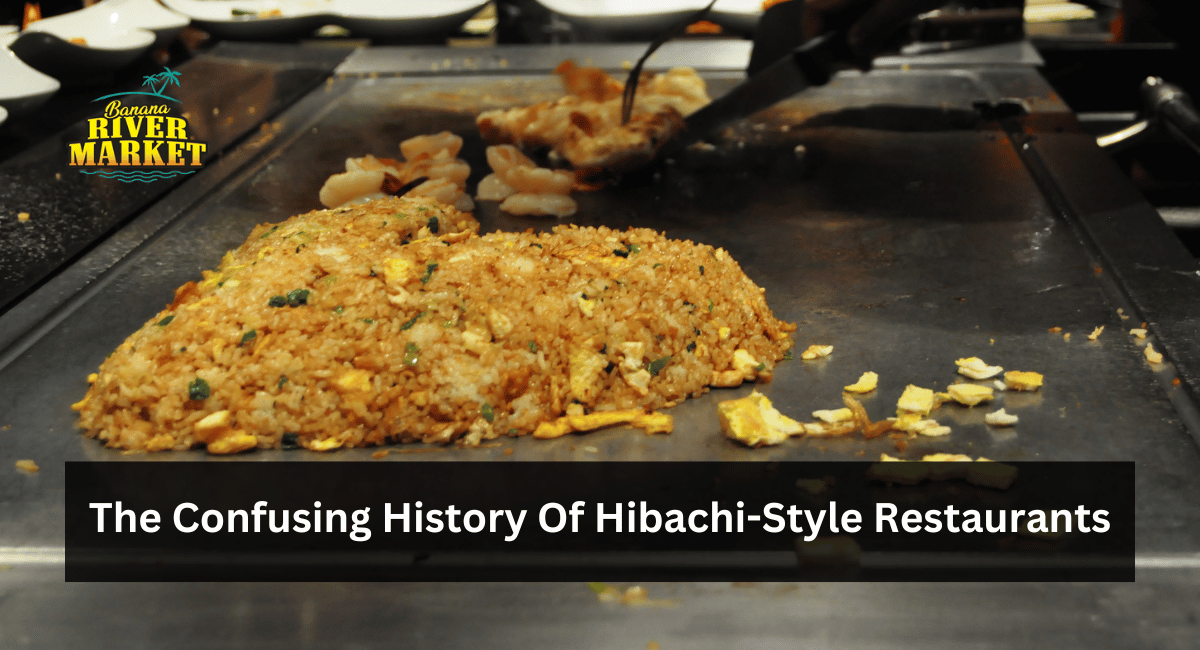If you’ve ever celebrated a birthday or a big occasion at a Japanese steakhouse, you probably recall the sizzling grill, egg-tossing chefs, and flaming onion volcanoes.
These lively dining experiences in North America are often called “hibachi-style” restaurants. However, there’s a bit of a twist: the correct term for this cooking style is teppanyaki, not hibachi. So, how did this popular dining trend become so widely misnamed, and what is its natural history?
This article delves into how these entertaining restaurants became an American sensation and why “hibachi” has been so commonly misused.
What’s the Difference Between Hibachi and Teppanyaki?
To understand the history of these Japanese steakhouses, let’s first clarify the terms “hibachi” and “teppanyaki,” which are often used interchangeably but refer to two distinct cooking methods.
Hibachi
The word “hibachi” refers to a traditional Japanese heating device that dates back to Japan’s Heian period (8th to 12th century). A hibachi is a container, usually made of ceramic or metal, to hold burning charcoal for warmth. While some people used hibachis for grilling small items or boiling water, the primary purpose was heating rooms or keeping hands warm, not cooking full meals.
Teppanyaki
The type of cooking commonly seen at Japanese-American steakhouses falls under teppanyaki, not hibachi. Teppanyaki cooking uses a teppan, a flat iron grill where chefs prepare food right before guests.
This style allows for the unique, interactive cooking techniques and showmanship that make these steakhouses popular. The chef’s culinary acrobatics—flipping utensils, cracking jokes, and creating the infamous onion volcano—are all hallmarks of teppanyaki.
The Rise of Teppanyaki Steakhouses in America
Teppanyaki may be an integral part of Japanese-American cuisine today, but its history is relatively recent. While some believe it started a few hundred years ago in Japan, others suggest it took off as a cooking style after World War II, especially with the arrival of American soldiers stationed in Japan. During this time, grilled beef on an iron griddle became popular, catering to American tastes.
One man, however, was primarily responsible for bringing teppanyaki to America—and making it a phenomenon.
How Benihana Shaped Japanese Steakhouses in America
In 1964, Japanese entrepreneur Hiroaki “Rocky” Aoki opened the first Benihana restaurant in Midtown Manhattan. Named after his parents’ coffee shop in Tokyo, which survived the 1945 firebombing, Aoki’s Benihana blended Japanese flavors and American flair.
Initially, the restaurant struggled, but a glowing review from food critic Clementine Paddleford in the New York Herald Tribune changed its fate.
From then on, the unique dining experience at Benihana attracted crowds. The chefs entertained with knife tricks, dramatic flips, and clever jokes, creating an atmosphere that went beyond a simple meal.
Aoki’s concept of dinner as a theatrical experience revolutionized the American dining scene and set the stage for countless other Japanese steakhouses that emulated Benihana’s teppanyaki style.
Why Are They Called “Hibachi” Restaurants in America?
Despite the popularity of teppanyaki, many Americans still call these restaurants “hibachi” style. But why the mix-up?
The confusion may refer to another Japanese cooking device: the shichirin, a small charcoal grill similar to a hibachi, often used for grilling skewers or small meats.
When teppanyaki gained popularity in America, the term “hibachi” was familiar to American diners because the shichirin had been called a “hibachi” in the U.S. for years.
This misnomer likely persisted because “shichirin” was more complicated for Americans to pronounce. As a result, the term “hibachi” became a blanket label for Japanese grilling methods, even though it was technically incorrect.
Benihana’s Efforts to Clear Up the Misunderstanding
Today, Benihana and other teppanyaki-style steakhouses acknowledge the mix-up between hibachi and teppanyaki on their websites, explaining their differences.
However, after decades of mislabeling, the term “hibachi” has firmly stuck in the American vocabulary when referring to Japanese steakhouse experiences.
Hibachi vs. Teppanyaki: A Quick Comparison
FeatureHibachiTeppanyaki
Main Use Heating, warming, occasional grilling Cooking meats, seafood, and vegetables
Equipment Small pot, ceramic or metal, uses charcoal Flat iron griddle
Showmanship Minimal, often stationary High-energy, chef-led performances
Standard in the U.S. Rare in restaurants Popular in Japanese-American steakhouses
The American Love for “Hibachi” Shows No Signs of Stopping
Despite the mix-up, Americans continue to flock to these “hibachi” or teppanyaki-style restaurants, fascinated by the lively showmanship and the skilled chefs.
The fusion of Japanese cooking and American entertainment is a winning combination, and the term “hibachi” has become synonymous with these experiences, regardless of its historical accuracy.
FAQs
What is the difference between hibachi and teppanyaki cooking?
Hibachi refers to a traditional heating device used for warmth and small-scale grilling. At the same time, teppanyaki involves cooking on a flat iron grill, often with chef-led performances that are popular in Japanese-American steakhouses.
Why do Americans call teppanyaki restaurants “hibachi”?
The term “hibachi” was used to describe a similar Japanese charcoal grill known as the shichirin, and the name stuck even as teppanyaki became popular in America. Benihana-style restaurants became known as “hibachi” steakhouses, even though they use teppanyaki grills.
Who introduced teppanyaki to America?
Hiroaki “Rocky” Aoki opened the first Benihana in New York City in 1964, introducing teppanyaki cooking to American audiences. His restaurant’s success helped popularize this interactive dining style across the country.
Is Benihana considered hibachi or teppanyaki?
Benihana and similar restaurants are technically teppanyaki-style, using a flat iron grill. However, they are commonly called “hibachi” in the United States, which is a misnomer.
Conclusion:
Whether called “hibachi” or “teppanyaki,” Japanese steakhouses in the U.S. remain a beloved tradition for many diners.
The blend of Japanese cooking methods and American-style entertainment has left a lasting impression, and while the terminology may be confusing, the experience is unforgettable.

